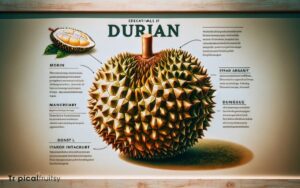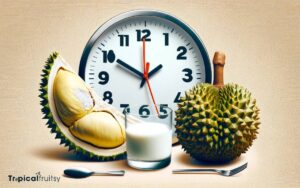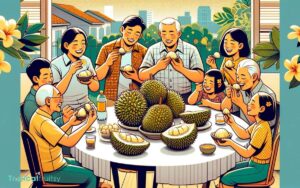What Is the Most Expensive Durian? Revealed!
The Musang King durian, also known as Mao Shan Wang, is the most expensive durian variety, renowned for its superior flavor and texture.
Durian fruit is highly valued in Southeast Asia, where it is considered the ‘King of Fruits’. The cost of durian can vary greatly depending on the type, source, and time of year.
Among the varieties, Musang King durian fetches the highest price, often due to its exceptional taste, which is a mix of sweet and bitter notes, and its creamy flesh.
The reasons behind its hefty price tag include the meticulous farming practices required and the high demand amongst durian enthusiasts.
Beyond its economic value, the Musang King durian holds cultural importance, signifying opulence and status in several Asian societies.
Musang King durian is the pinnacle of indulgence for fruit lovers, embodying a luxurious eating experience.
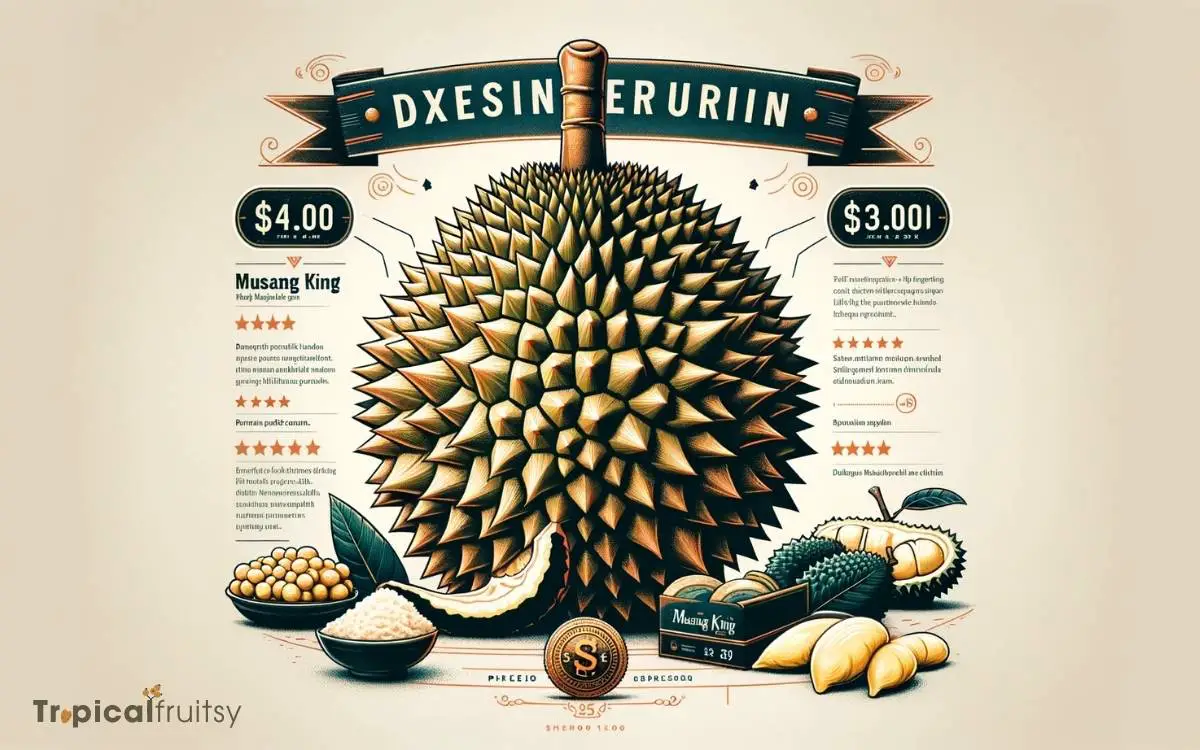
Key Takeaway
The Most Expensive Durian: Musang King Price and Profile
| Durian Variety | Price Range | Flavor Profile | Texture | Season | Cultural Significance |
|---|---|---|---|---|---|
| Musang King | High | Bittersweet | Creamy | Seasonal | Luxury, Status |
The Allure of Durian
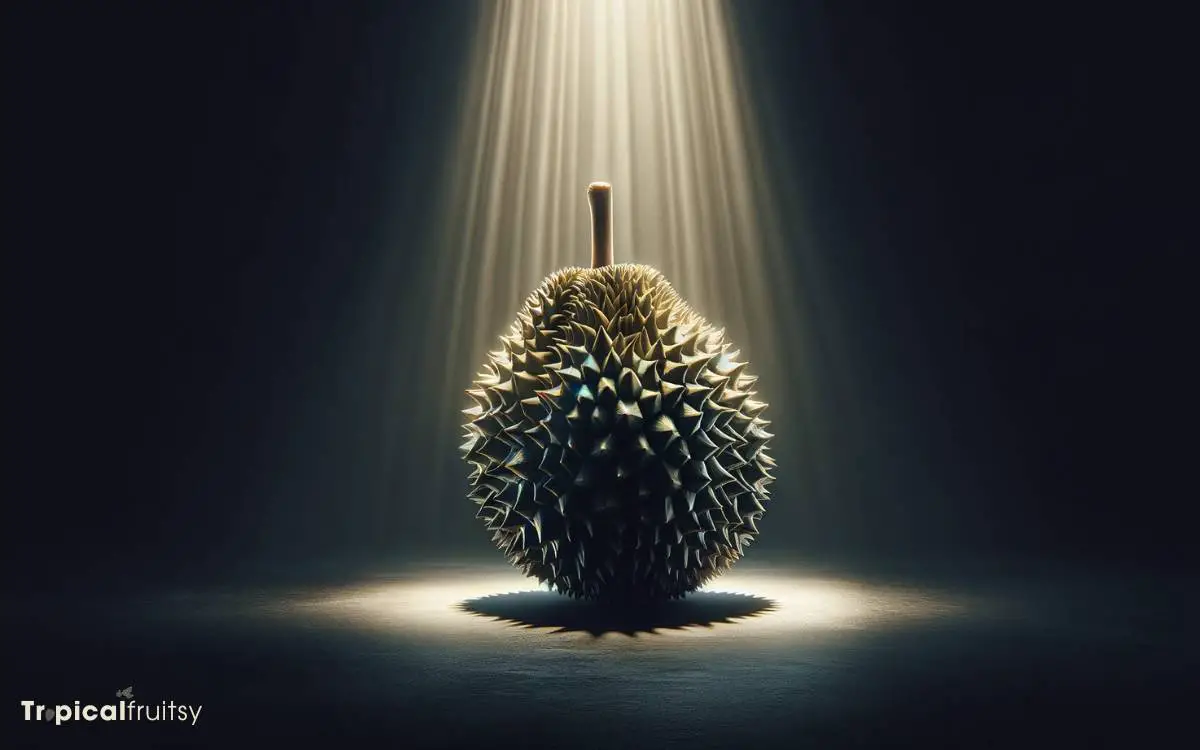
The allure of durian, often referred to as the ‘King of Fruits’, lies in its unique combination of creamy texture, intense flavor, and distinctive aroma that captivates enthusiasts worldwide.
This formidable fruit demands a discerning palate, with its rich custard-like flesh that can range from sweet to savory, encased within a spiky, formidable husk.
For many, the durian experience is a complex sensory journey, with aromatic notes that have been compared to everything from almonds to caramel, often leaving an indelible impression.
It is this complexity and depth of flavor that establishes durian as a culinary treasure, revered by connoisseurs and sought after by the adventurous.
Understanding this mesmerizing appeal is essential before delving into the factors that influence its market value.
Factors Influencing Price
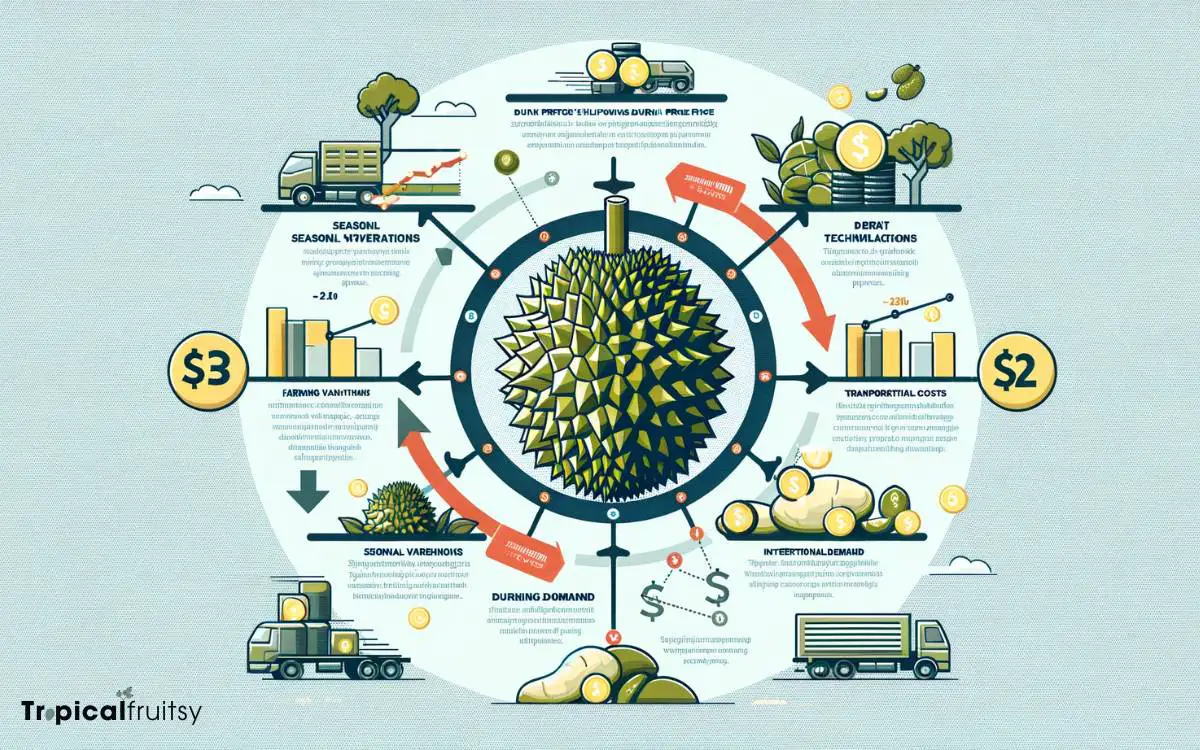
Durian’s mystique significantly contributes to its valuation, with several key factors determining the price of this esteemed fruit.
Rarity and seasonality are at the forefront, with coveted varieties like the Malaysian ‘Musang King’ commanding premium prices.
The labor-intensive cultivation, including precise agricultural practices and the necessity for hand pollination, also escalates costs.
Moreover, the fruit’s perishability demands swift, careful handling and transportation, further inflating expenses.
Consumer demand plays a pivotal role, too; in regions where durian is revered, afficionados are willing to pay top dollar for exceptional quality and taste.
Top-Tier Durian Varieties
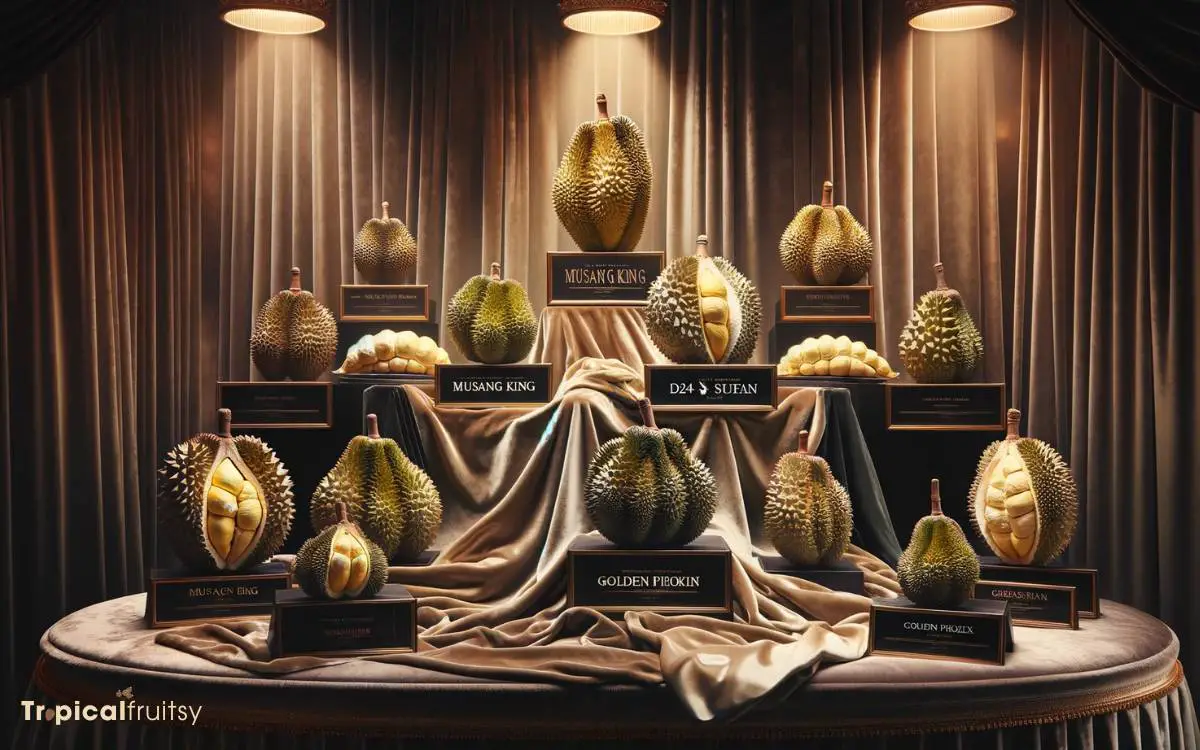
Amidst the myriad of durian varieties, certain cultivars stand out for their exquisite taste and commanding market prices, notably the ‘Musang King’ and ‘Black Thorn’ from Malaysia.
The Musang King, revered for its creamy texture and deeply satisfying bittersweet taste, is often the benchmark for premium durians.
On the other hand, Black Thorn, a relative newcomer, has quickly ascended the ranks with its complex flavor profile that promises a lingering sweetness and hints of a fine, alcoholic fermentation.
Here is a succinct comparison of these top-tier durian varieties:
| Variety | Origin | Flavor Profile |
|---|---|---|
| Musang King | Malaysia | Creamy, bittersweet, rich |
| Black Thorn | Malaysia | Sweet, alcoholic fermentation notes |
| D24 Sultan | Malaysia | Bitter, less creamy than Musang King |
These varieties, through their unparalleled taste and texture, have cultivated a passionate following among durian connoisseurs worldwide.
Musang King: The Priciest
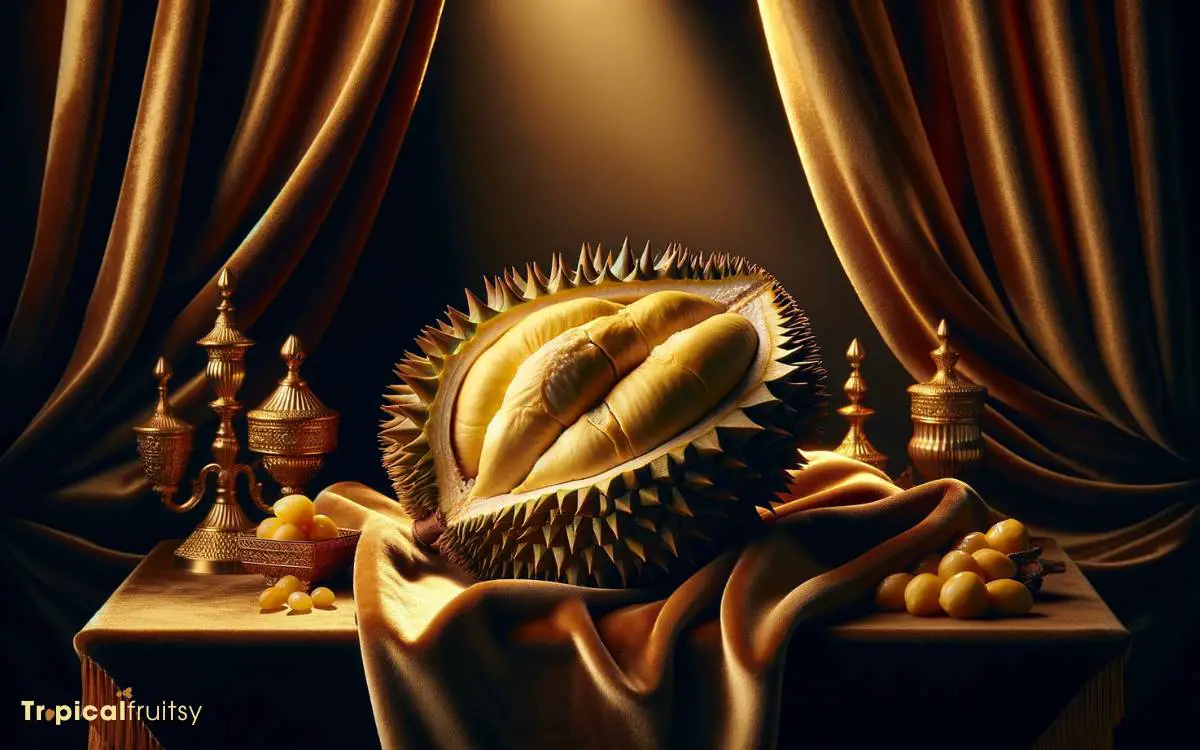
Musang King reigns supreme in the pantheon of durian, commanding unparalleled prices that reflect its superior flavor profile—a complex tapestry of creamy sweetness and bitter notes that mesmerize connoisseurs.
Its scarcity and voracious market demand underpin its lofty valuation, as aficionados around the globe clamor for a taste of this exquisite fruit.
Moreover, the intricate and cost-intensive cultivation process, requiring precise agricultural expertise, further justifies the premium attached to Musang King, making it a luxury item among tropical fruits.
Flavor Profile
The flavor profile of Musang King durian, renowned for its creamy texture and complex taste, is a primary factor contributing to its status as the most expensive variety of durian.
Connoisseurs prize the Musang King for its bittersweet symphony and rich custard-like consistency that coats the palate with a decadent, velvety embrace.
The luscious flesh offers a nuanced balance of sweet and savory, with hints of roasted almonds, a whisper of chives, and a subtle note of caramel, ending in a pleasantly lingering, sophisticated finish.
Each segment of Musang King’s golden-hued flesh promises an olfactory and gustatory delight, a testament to its unrivaled supremacy in the pantheon of tropical fruits.
Its distinct, full-bodied flavor is the epitome of indulgence, capturing the essence of luxury in every bite.
High Demand Factors
Beyond its sensory appeal, the Musang King durian commands a premium price due to several factors. This includes limited cultivation areas, labor-intensive farming practices, and increasing global demand.
Grown predominantly in Malaysia, the Musang King variety, also known as Mao Shan Wang, requires specific climatic conditions and expert care to flourish.
The cultivation involves meticulous attention to soil quality, tree health, and pest control. These factors are fundamental to producing the superior quality fruit known for its rich, creamy texture and potent aroma.
Enthusiasts and connoisseurs around the world are willing to pay top dollar for this golden-fleshed delicacy, driving prices to unparalleled heights.
The allure of the Musang King is not merely in its taste but also in its rarity and the dedication behind its cultivation.
Cultivation Costs
Considering its intricate cultivation process, the Musang King variety stands as the most expensive durian, with costs significantly influenced by the extensive labor and precise agricultural expertise required.
Enthusiasts and cultivators alike acknowledge that Musang King trees demand a harmonious blend of ideal soil conditions and diligent care to produce their coveted fruit.
Each tree must be painstakingly monitored for the perfect balance of nutrients and water, and protected against a myriad of pests and diseases that can devastate crops.
The meticulous attention to detail extends to the harvest, where timing is critical to ensure peak ripeness and flavor.
This labor-intensive and knowledge-driven process justifies the premium price of Musang King durians, reflecting the dedication and passion infused in every step from soil to platter.
Harvesting and Availability
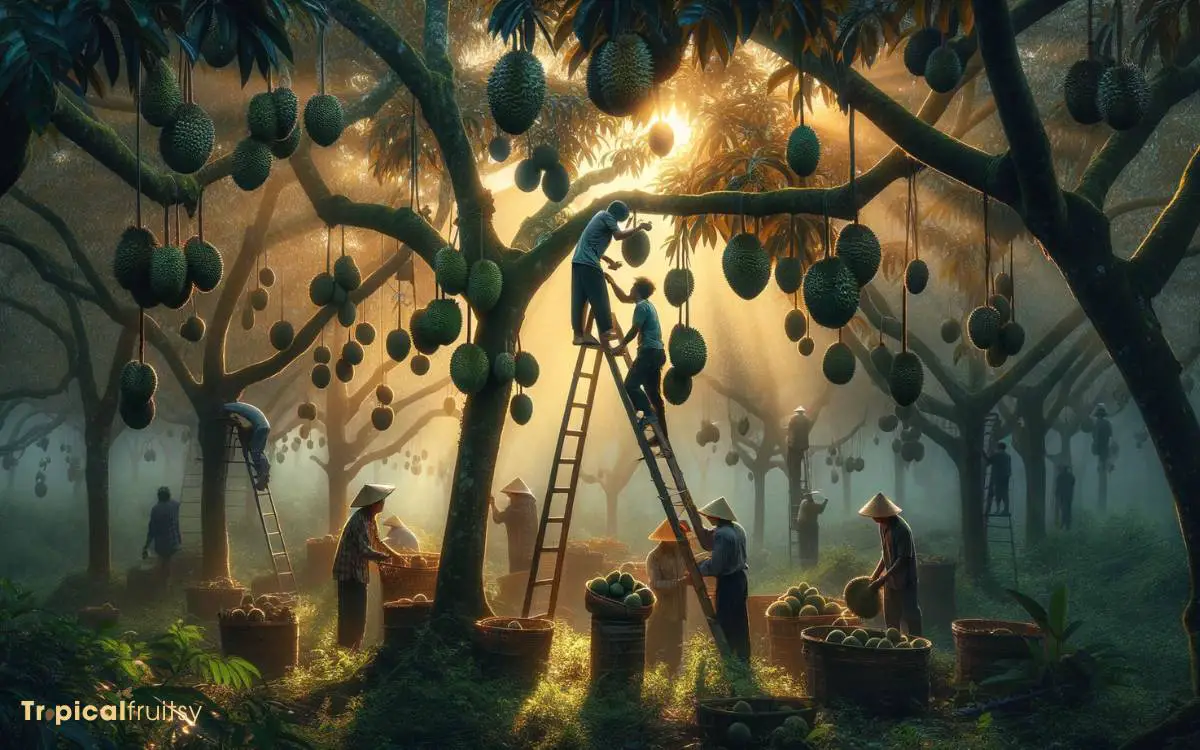
Durians are typically harvested during their peak seasons, which generally occur annually between June and August, making them available for a limited period each year.
The scarcity of these exotic fruits outside their natural harvest time adds to their allure and value. Discerning consumers eagerly anticipate the arrival of the durian season to savor the rich, custard-like flesh that is both pungent and sweet.
Key factors in the harvesting and availability of durians include:
- Climatic Conditions: Durians require specific weather patterns for optimal growth, affecting both yield and timing.
- Harvesting Techniques: Skilled labor is essential to carefully harvest durians, ensuring the highest quality without damage.
- Market Demand: Global and domestic markets influence the distribution, further impacting availability and price.
These elements combine to make the durian both a seasonal and luxurious treat.
Record-Breaking Durian Sales
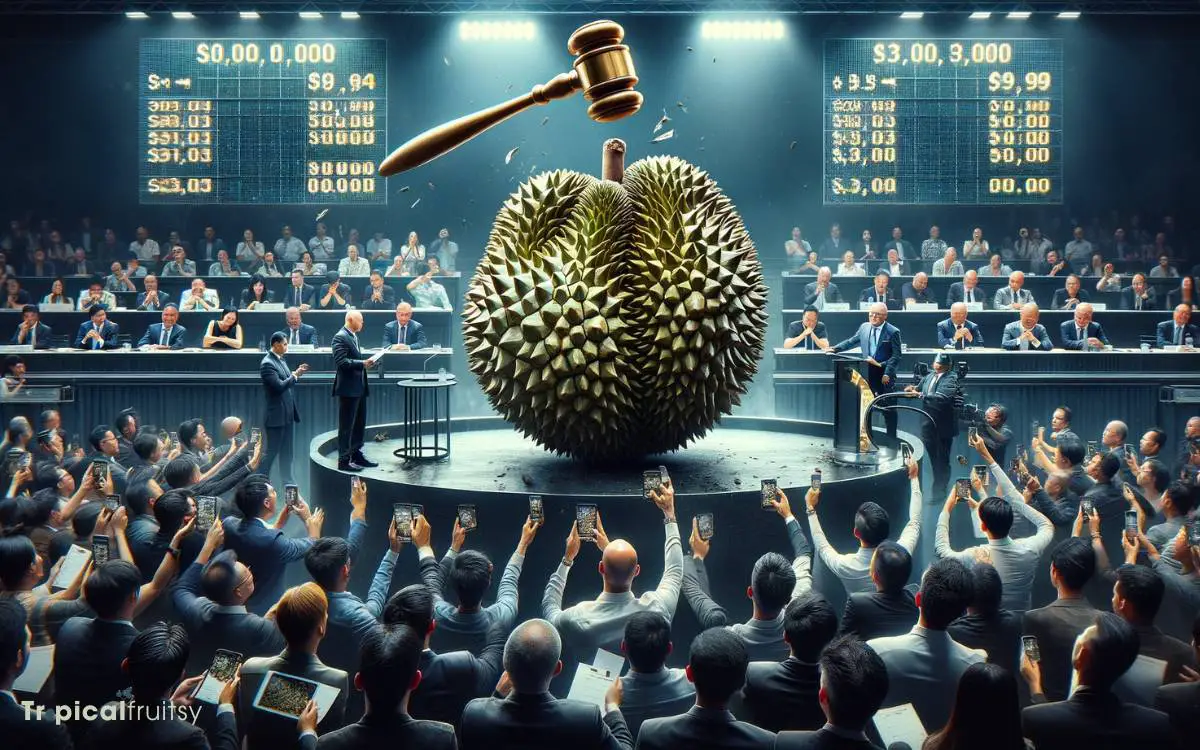
The world of exotic fruits has witnessed jaw-dropping auction prices for durians, underscoring a thriving luxury market for this unique delicacy.
Record-breaking sales not only reflect the fruit’s rarity and distinctive taste but also the growing appetite of affluent consumers for exclusive gastronomic experiences.
The surge in auction price peaks for durians is a testament to the fruit’s status as a symbol of opulence and the zenith of tropical indulgence.
Auction Price Peaks
Record-breaking auction sales have seen individual durians fetching exorbitant prices, reflecting the fruit’s luxury status among enthusiasts.
These pinnacles of pricing are not mere flukes; they are the culmination of rarity, quality, and prestige converging in a single fruit.
For connoisseurs, these moments are not just transactions but celebrations of a horticultural masterpiece.
Key auction price peaks include:
- The 2019 King of Durian Auction in Thailand, where a Kanyao durian sold for an astounding 1.5 million baht (approximately $48,000 USD).
- The 2020 Charity Auction in Malaysia, witnessing a Musang King durian snapped up for 800,000 ringgit (around $200,000 USD).
- Singapore’s 2021 Thieves Market, where a rare Black Thorn variety fetched an unprecedented S$2,600 (nearly $1,900 USD) per fruit.
These record prices underscore the durian’s standing as the apex of tropical fruit luxury, coveted by aficionados and collectors alike.
Luxury Fruit Demand
Amidst the surge in global affluence, the demand for luxury fruits such as the durian has escalated, leading to record-breaking sales at prestigious auctions.
Connoisseurs and collectors, driven by a passion for the most exquisite tastes and rarities, have elevated the durian to a symbol of status and opulence.
The fervor for these thorn-clad treasures is not merely about indulgence; it is a complex ritual of appreciation for the pinnacle of agricultural craftsmanship.
Each record sale is a testament to the durian’s evolving legacy as a luxury commodity, reflecting the refined palates of the elite.
As the market thrives, it is clear that the appetite for such exceptional produce is not merely a trend, but a persistent pursuit of the extraordinary.
Beyond Price: Cultural Impact
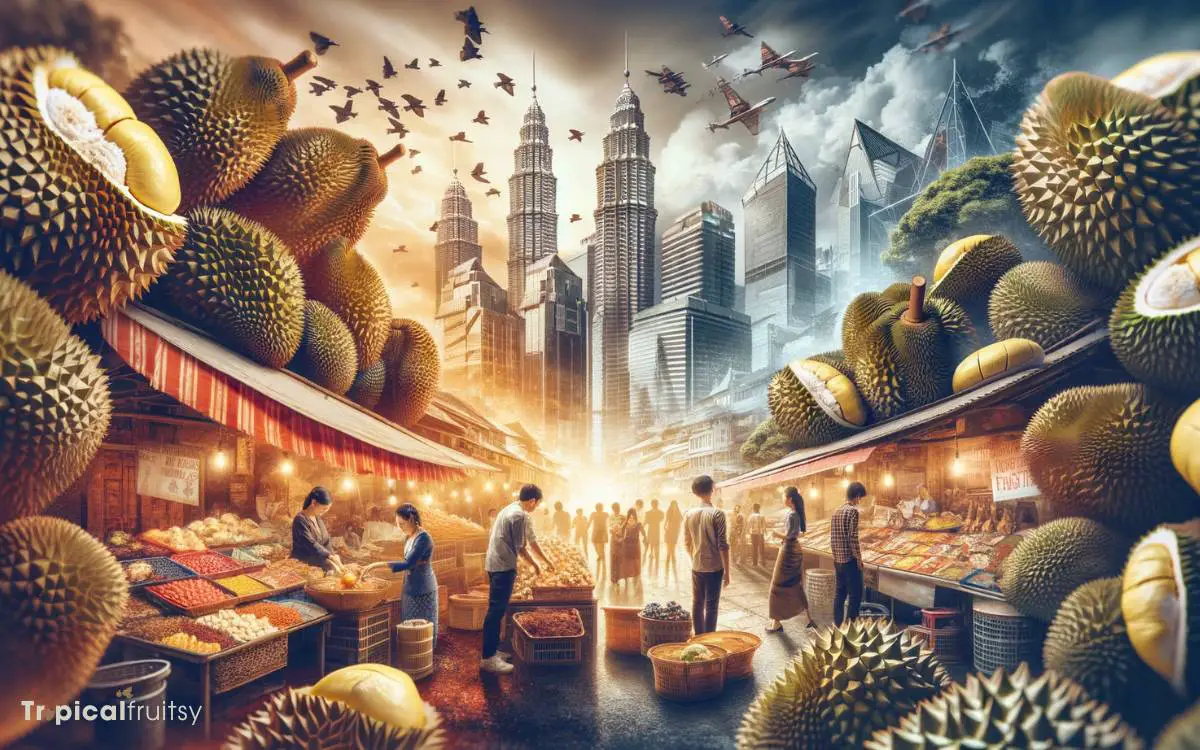
Beyond its staggering price tag, the durian fruit holds a deep cultural significance in Southeast Asia, where it is revered as the ‘King of Fruits.’
This veneration stems not merely from its unique taste and smell, but also from its embodiment of a rich cultural heritage that transcends mere consumption.
The durian is interwoven into the social and economic tapestry of the region, manifesting in various significant ways:
- Culinary Celebrations: It is a centerpiece in festive occasions and a subject of culinary competitions, inspiring chefs to innovate traditional and modern recipes.
- Agricultural Heritage: Durian cultivation is a generational craft, often shaping the livelihoods and identities of rural communities.
- Symbolic Presence: The fruit features in local art, folklore, and literature, symbolizing abundance, strength, and the enduring spirit of the people.
The durian’s impact is thus measured not just in currency, but in the cherished narratives it helps to continue and the communal bonds it reinforces.
Conclusion
The Musang King reigns supreme in the realm of durians, commanding exorbitant prices that reflect its coveted status.
This king of fruits, with its unparalleled taste and texture, not only signifies luxury but also embodies cultural richness, often acting as a social linchpin in festive gatherings.
Its value transcends monetary worth, encapsulating a heritage that resonates deeply within the hearts of connoisseurs, thus weaving an intricate tapestry of tradition and gastronomic prestige.

